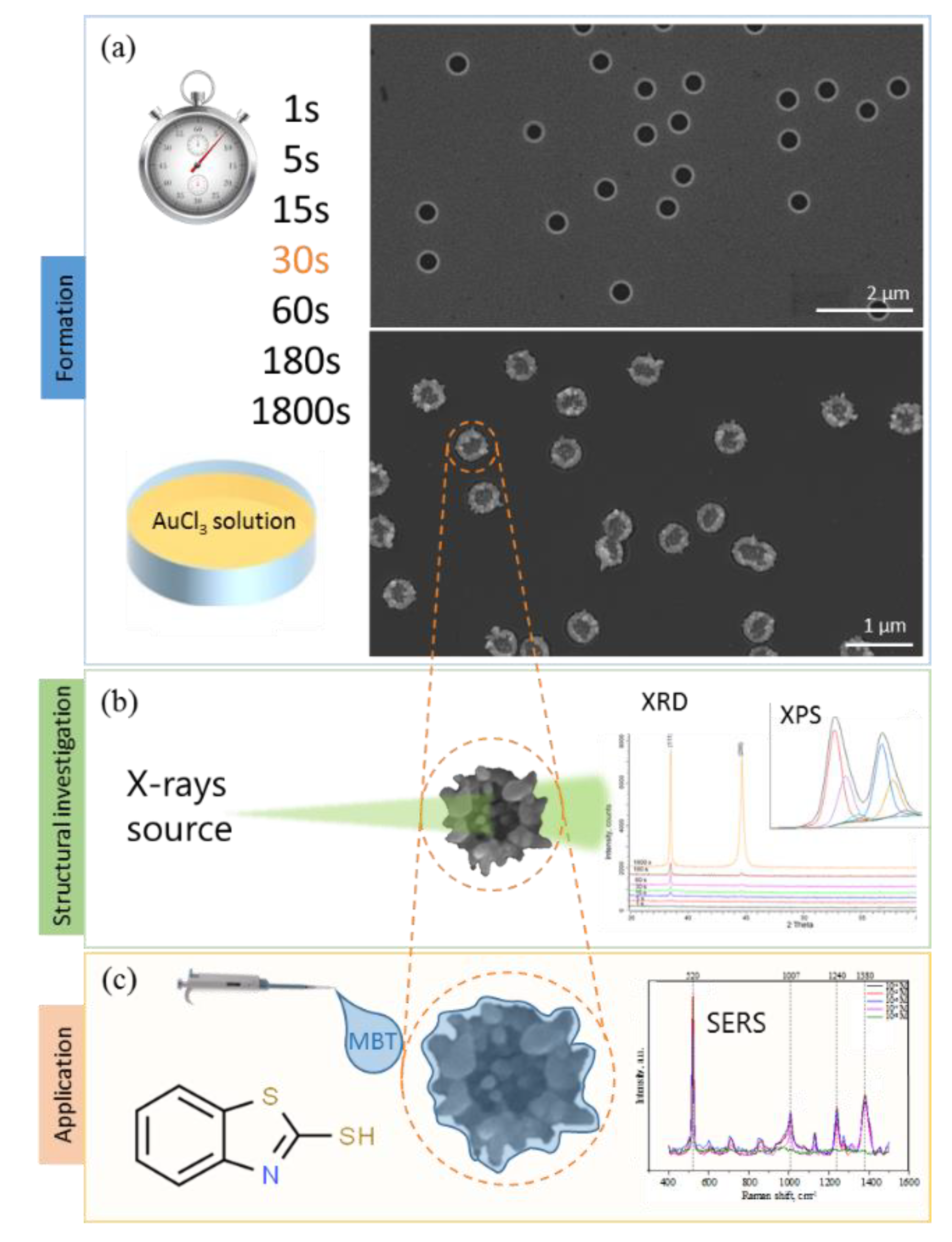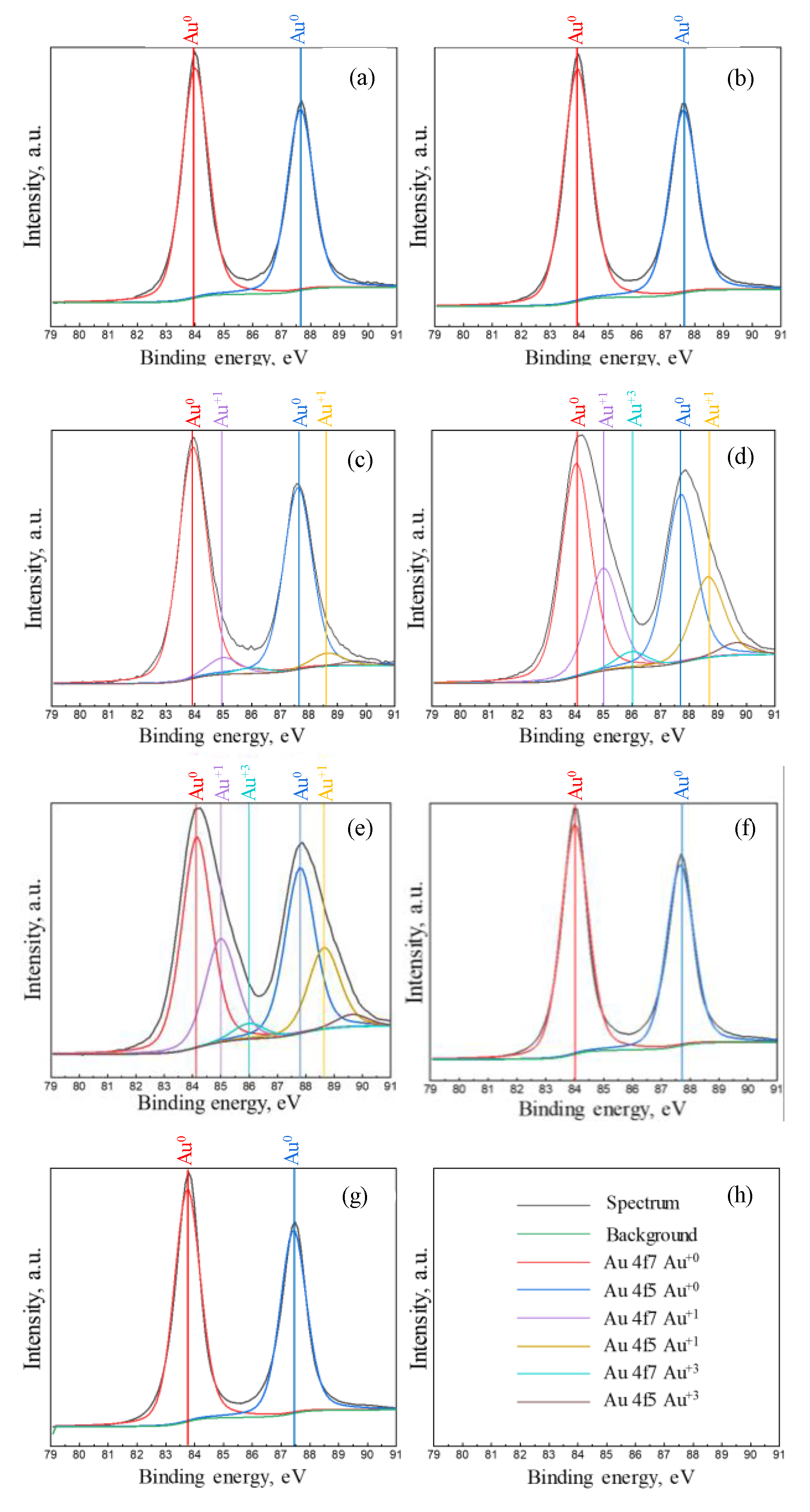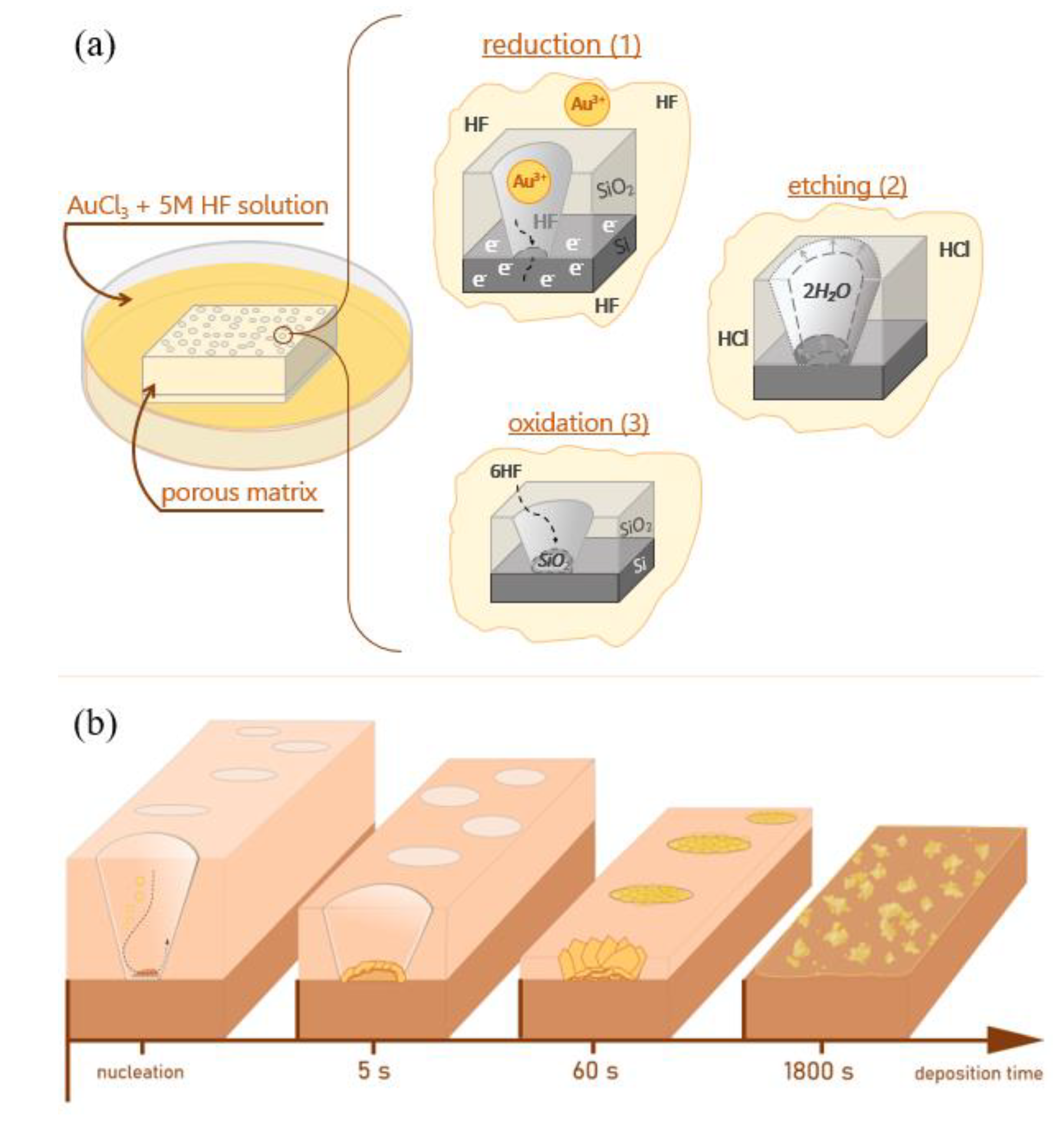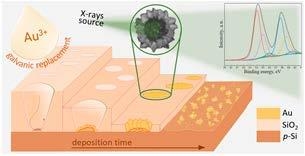Morphology and Microstructure Evolution of Gold Nanostructures in the Limited Volume Porous Matrices
Abstract
1. Introduction
2. Materials and Methods
3. Results and Discussion
3.1. Gold Nanostructures’ Morphology
3.2. X-Ray Diffraction of Gold Nanostructures
3.3. XPS Studies of Obtained Gold Nanostructures
3.4. SERS on Obtained Gold Nanostructures
4. Conclusions
Author Contributions
Funding
Acknowledgments
Conflicts of Interest
References
- Sharma, B.; Frontiera, R.R.; Henry, A.I.; Ringe, E.; Van Duyne, R.P. SERS: Materials, applications, and the future. Mater. Today 2012, 15, 16–25. [Google Scholar] [CrossRef]
- Betz, J.F.; Yu, W.W.; Cheng, Y.; White, M.; Rubloff, G.W. Simple SERS substrates: Powerful, portable, and full of potential. Phys. Chem. Chem. Phys. 2014, 16, 2224–2239. [Google Scholar] [CrossRef] [PubMed]
- Wang, A.X.; Kong, X. Review of Recent Progress of Plasmonic Materials and Nano-Structures for Surface-Enhanced Raman Scattering. Materials 2015, 8, 3024. [Google Scholar] [CrossRef]
- Sun, X.; Lin, L.; Li, Z.; Zhang, Z. Feng, Novel Ag–Cu substrates for surface-enhanced Raman scattering. Mater. Lett. 2009, 63, 2306–2308. [Google Scholar] [CrossRef]
- Panarin, A.Y.; Terekhov, S.N.; Kholostov, K.I.; Bondarenko, V.P. SERS-active substrates based on n-type porous silicon. Appl. Surf. Sci. 2010, 256, 6969–6976. [Google Scholar] [CrossRef]
- Bandarenka, H.; Artsemyeva, K.; Redko, S.; Panarin, A.; Terekhov, S.; Bondarenko, V. Effect of swirl-like resistivity striations in n+-type Sb doped Si wafers on the properties of Ag/porous silicon SERS substrates. Phys. Status Solidi C 2013, 10, 624–627. [Google Scholar] [CrossRef]
- Liu, R.; Li, S.; Yu, X.; Zhang, G.; Ma, Y.; Yao, J.; Keita, B.; Nadjo, L. Polyoxometalate-Assisted Galvanic Replacement Synthesis of Silver Hierarchical Dendritic Structures. Cryst. Growth Des. 2011, 11, 3424–3431. [Google Scholar] [CrossRef]
- Jia, W.; Li, J.; Lin, G.; Jiang, L. Two-Step Synthesis of Narrow Size Distribution Nanoflowers Using a Tree-Type Multi-Amine-Head Surfactant as a Template. Cryst. Growth Des. 2011, 11, 3822–3827. [Google Scholar] [CrossRef]
- Gonçalves, M.R. Plasmonic nanoparticles: Fabrication, simulation and experiments. J. Phys. D Appl. Phys. 2014, 47, 213001. [Google Scholar] [CrossRef]
- Ding, S.-Y.; You, E.-M.; Tian, Z.-Q.; Moskovits, M. Electromagnetic theories of surface-enhanced Raman spectroscopy. Chem. Soc. Rev. 2017, 46, 4042–4076. [Google Scholar] [CrossRef]
- Wei, H.; Xu, H. Hot spots in different metal nanostructures for plasmon-enhanced Raman spectroscopy. Nanoscale 2013, 5, 10794–10805. [Google Scholar] [CrossRef] [PubMed]
- Gopalakrishnan, A.; Chirumamilla, M.; De Angelis, F.; Toma, A.; Zaccaria, R.P.; Krahne, R. Bimetallic 3D Nanostar Dimers in Ring Cavities: Recyclable and Robust Surface-Enhanced Raman Scattering Substrates for Signal Detection from Few Molecules. ACS Nano 2014, 8, 7986–7994. [Google Scholar] [CrossRef] [PubMed]
- Qiu, T.; Zhou, Y.; Li, J.; Zhang, W.; Lang, X.; Cui, T.; Chu, P.K. Hot spots in highly Raman-enhancing silver nano-dendrites. J. Phys. D Appl. Phys. 2009, 42, 175403. [Google Scholar] [CrossRef]
- Hong, X.; Wang, G.; Wang, Y.; Zhu, W.; Shen, X. Controllable Electrochemical Synthesis of Silver Dendritic Nanostructures and Their SERS Properties. Chin. J. Chem. Phys. 2010, 23, 596. [Google Scholar] [CrossRef]
- Dao, T.C.; Luong, T.Q.N.; Cao, T.A.; Kieu, N.M.; Le, V.V. Application of silver nanodendrites deposited on silicon in SERS technique for the trace analysis of paraquat. Adv. Nat. Sci. Nanosci. Nanotechnol. 2016, 7, 015007. [Google Scholar] [CrossRef]
- Wang, D.; Li, T.; Liu, Y.; Huang, J.; You, T. Large-Scale and Template-Free Growth of Free-Standing Single-Crystalline Dendritic Ag/Pd Alloy Nanostructure Arrays. Cryst. Growth Des. 2009, 9, 4351–4355. [Google Scholar] [CrossRef]
- Han, Y.; Liu, S.; Han, M.; Bao, J.; Dai, Z. Fabrication of Hierarchical Nanostructure of Silver via a Surfactant-Free Mixed Solvents Route. Cryst. Growth Des. 2009, 9, 3941–3947. [Google Scholar] [CrossRef]
- Ng, C.H.B.; Fan, W.Y. Preparation of Ag Stellar Dendrites: Modeling the Growth of Stellar Snowflakes. Cryst. Growth Des. 2014, 14, 6067–6072. [Google Scholar] [CrossRef]
- Tiwari, P.; Vig, K.; Dennis, V.; Singh, S. Functionalized Gold Nanoparticles and Their Biomedical Applications. Nanomaterials 2011, 1, 31–63. [Google Scholar] [CrossRef]
- Bibikova, O.; Popov, A.; Bykov, A.; Fales, A.; Yuan, H.; Skovorodkin, I.; Kinnunen, M.; Vainio, S.; Vo-Dinh, T.; Tuchin, V.V.; et al. Plasmon-Resonant Gold Nanostars With Variable Size as Contrast Agents for Imaging Applications. IEEE J. Sel. Top. Quantum Electron. 2016, 22, 13–20. [Google Scholar] [CrossRef]
- Schlücker, S. Surface-Enhanced Raman Spectroscopy: Concepts and Chemical Applications. Angew. Chem. Int. Ed. 2014, 53, 4756–4795. [Google Scholar] [CrossRef] [PubMed]
- Mettela, G.; Siddhanta, S.; Narayana, C.; Kulkarni, G.U. Nanocrystalline Ag microflowers as a versatile SERS platform. Nanoscale 2014, 6, 7480–7488. [Google Scholar] [CrossRef] [PubMed]
- Yakimchuk, D.; Kaniukov, E.; Bundyukova, V.; Osminkina, L.; Teichert, S.; Demyanov, S.; Sivakov, V. Silver nanostructures evolution in porous SiO2/p-Si matrices for wide wavelength surface-enhanced Raman scattering applications. MRS Commun. 2018, 8, 95–99. [Google Scholar] [CrossRef]
- Kaniukov, E.; Yakimchuk, D.; Arzumanyan, G.; Terryn, H.; Baert, K.; Kozlovskiy, A.; Zdorovets, M.; Belonogov, E.; Demyanov, S. Growth mechanisms of spatially separated copper dendrites in pores of a SiO2 template. Philos. Mag. 2017, 97, 2268–2283. [Google Scholar] [CrossRef]
- Sivakov, V.; Kaniukov, E.Y.; Petrov, A.V.; Korolik, O.V.; Mazanik, A.V.; Bochmann, A.; Teichert, S.; Hidi, I.J.; Schleusener, A.; Cialla, D.; et al. Silver nanostructures formation in porous Si/SiO2 matrix. J. Cryst. Growth 2014, 400, 21–26. [Google Scholar] [CrossRef]
- Kaniukov, E.Y.; Ustarroz, J.; Yakimchuk, D.V.; Petrova, M.; Terryn, H.; Sivakov, V.; Petrov, A.V. Tunable nanoporous silicon oxide templates by swift heavy ion tracks technology. Nanotechnology 2016, 27, 115305. [Google Scholar] [CrossRef]
- Osminkina, L.A.; Žukovskaja, O.; Agafilushkina, S.N.; Kaniukov, E.; Stranik, O.; Gonchar, K.A.; Yakimchuk, D.; Bundyukova, V.; Chermoshentsev, D.A.; Dyakov, S.A.; et al. Gold nanoflowers grown in a porous Si/SiO2 matrix: The fabrication process and plasmonic properties. Appl. Surf. Sci. 2020, 507, 144989. [Google Scholar] [CrossRef]
- Monk, D.J.; Soane, D.S.; Howe, R.T. A review of the chemical reaction mechanism and kinetics for hydrofluoric acid etching of silicon dioxide for surface micromachining applications. Thin Solid Films 1993, 232, 1–12. [Google Scholar] [CrossRef]
- Radnik, J.; Mohr, C.; Claus, P. On the origin of binding energy shifts of core levels of supported gold nanoparticles and dependence of pretreatment and material synthesis. Phys. Chem. Chem. Phys. 2003, 5, 172–177. [Google Scholar] [CrossRef]
- Sankar, M.; He, Q.; Morad, M.; Pritchard, J.; Freakley, S.J.; Edwards, J.K.; Taylor, S.H.; Morgan, D.J.; Carley, A.F.; Knight, D.W.; et al. Synthesis of Stable Ligand-free Gold–Palladium Nanoparticles Using a Simple Excess Anion Method. ACS Nano 2012, 6, 6600–6613. [Google Scholar] [CrossRef]
- Rahsepar, F.R.; Leung, K.T. Biohybridization of Supported Gold Nanoassemblies on Silicon. J. Phys. Chem. C 2018, 122, 16113–16121. [Google Scholar] [CrossRef]
- Bhattacharya, D.; Johnson, A.A.; Sorem, R.K.; Andersen, G.A. The room-temperature dissociation of the compound Au3Si. Mater. Sci. Eng. 1978, 32, 181–184. [Google Scholar] [CrossRef]
- Chen, X.; Liang, C. Transition metal silicides: Fundamentals, preparation and catalytic applications. Catal. Sci. Technol. 2019, 9, 4785–4820. [Google Scholar] [CrossRef]
- Song, C.; Wang, Z.; Yang, J.; Zhang, R.; Cui, Y. Preparation of 2-mercaptobenzothiazole-labeled immuno-Au aggregates for SERS-based immunoassay. Colloids Surf. B Biointerfaces 2010, 81, 285–288. [Google Scholar] [CrossRef] [PubMed]
- Žukovskaja, O.; Agafilushkina, S.; Sivakov, V.; Weber, K.; Cialla-May, D.; Osminkina, L.; Popp, J. Rapid detection of the bacterial biomarker pyocyanin in artificial sputum using a SERS-active silicon nanowire matrix covered by bimetallic noble metal nanoparticles. Talanta 2019, 202, 171–177. [Google Scholar] [CrossRef] [PubMed]
- Chen, Y.H.; Erbe, A. The multiple roles of an organic corrosion inhibitor on copper investigated by a combination of electrochemistry-coupled optical in situ spectroscopies. Corros. Sci. 2018, 145, 232–238. [Google Scholar] [CrossRef]







| Deposition Time | Phase | Space Group | (hkl) | Crystallite Size, nm | Cell Parameter, Å | FWHM |
|---|---|---|---|---|---|---|
| 1 s | amorph | — | — | — | — | — |
| 5 s | amorph | — | — | — | — | — |
| 15 s | cubic | Fm-3 m(225) | 111 | 88.68 | 4.05061 | 0.105 |
| 30 s | cubic | Fm-3 m(225) | 111 | 88.00 | 4.05223 | 0.106 |
| 60 s | cubic | Fm-3 m(225) | 111 | 111.42 | 4.04901 | 0.084 |
| 200 | 53.35 | 0.179 | ||||
| 220 | 80.35 | 0.130 | ||||
| 180 s | cubic | Fm-3m(225) | 111 | 88.90 | 4.04740 | 0.105 |
| 200 | 56.74 | 0.168 | ||||
| 220 | 65.07 | 0.161 | ||||
| 1800 s | cubic | Fm-3m(225) | 111 | 105.10 | 4.04901 | 0.089 |
| 200 | 34.10 | 0.280 | ||||
| 220 | 95.26 | 0.110 |
© 2020 by the authors. Licensee MDPI, Basel, Switzerland. This article is an open access article distributed under the terms and conditions of the Creative Commons Attribution (CC BY) license (http://creativecommons.org/licenses/by/4.0/).
Share and Cite
Yakimchuk, D.V.; Bundyukova, V.D.; Ustarroz, J.; Terryn, H.; Baert, K.; Kozlovskiy, A.L.; Zdorovets, M.V.; Khubezhov, S.A.; Trukhanov, A.V.; Trukhanov, S.V.; et al. Morphology and Microstructure Evolution of Gold Nanostructures in the Limited Volume Porous Matrices. Sensors 2020, 20, 4397. https://doi.org/10.3390/s20164397
Yakimchuk DV, Bundyukova VD, Ustarroz J, Terryn H, Baert K, Kozlovskiy AL, Zdorovets MV, Khubezhov SA, Trukhanov AV, Trukhanov SV, et al. Morphology and Microstructure Evolution of Gold Nanostructures in the Limited Volume Porous Matrices. Sensors. 2020; 20(16):4397. https://doi.org/10.3390/s20164397
Chicago/Turabian StyleYakimchuk, Dzmitry V., Victoria D. Bundyukova, Jon Ustarroz, Herman Terryn, Kitty Baert, Artem L. Kozlovskiy, Maxim V. Zdorovets, Soslan A. Khubezhov, Alex V. Trukhanov, Sergei V. Trukhanov, and et al. 2020. "Morphology and Microstructure Evolution of Gold Nanostructures in the Limited Volume Porous Matrices" Sensors 20, no. 16: 4397. https://doi.org/10.3390/s20164397
APA StyleYakimchuk, D. V., Bundyukova, V. D., Ustarroz, J., Terryn, H., Baert, K., Kozlovskiy, A. L., Zdorovets, M. V., Khubezhov, S. A., Trukhanov, A. V., Trukhanov, S. V., Panina, L. V., Arzumanyan, G. M., Mamatkulov, K. Z., Tishkevich, D. I., Kaniukov, E. Y., & Sivakov, V. (2020). Morphology and Microstructure Evolution of Gold Nanostructures in the Limited Volume Porous Matrices. Sensors, 20(16), 4397. https://doi.org/10.3390/s20164397











